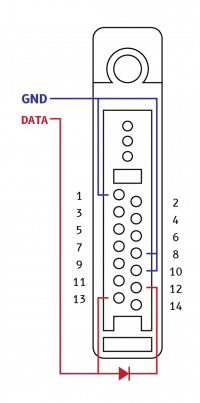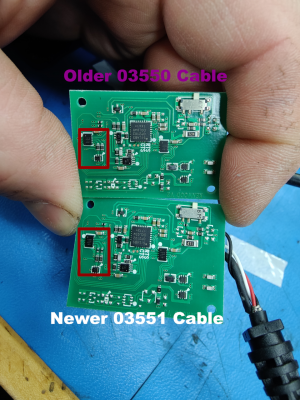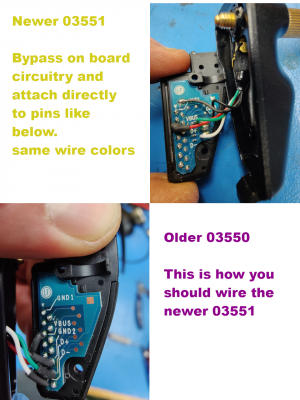VP8000: Difference between revisions
No edit summary |
|||
| (7 intermediate revisions by the same user not shown) | |||
| Line 56: | Line 56: | ||
|- | |- | ||
| TX, UHF, 5W || | | TX, UHF, 5W || | ||
|} | |||
=== Bluetooth Compatability === | |||
Below is a curated list of bluetooth devices that have been confirmed either '''working''' or '''non-working'''. If you have bluetooth devices you've tested that aren't on this list, please [https://w3axl.com/?page_id=345 email us]! | |||
{| class="wikitable sortable" | |||
|+ | |||
!Manufacturer | |||
!Model | |||
!Compatible | |||
!Notes | |||
|- | |||
|Apple | |||
|AirPods 2 | |||
|✅ Yes | |||
|Pairing is a little finnicky but RX audio does work fine | |||
|- | |||
|GoNovate | |||
|G10 | |||
|✅ Yes | |||
|Works as an RX-only headset, no PTT | |||
|- | |||
|GoNovate | |||
|G8 | |||
|❌ No | |||
|Pairs but presents Serial Port Profile (SPP) first, preventing audio from functioning | |||
|- | |||
|JLab | |||
|JBuds Mini | |||
|❌ No | |||
|Pairs but audio does not work | |||
|- | |||
|NVAHVA | |||
|J18 | |||
|❌ No | |||
|Does not pair properly | |||
|- | |||
|Sony | |||
|WF-C510 | |||
|✅ Yes | |||
| | |||
|- | |||
|Sony | |||
|WF-XB700 | |||
|✅ Yes | |||
| | |||
|- | |||
|Sony | |||
|WH-100XM4 | |||
|✅ Yes | |||
| | |||
|- | |||
|SYSFUN | |||
|X7 | |||
|❌ No | |||
|Does not pair properly | |||
|} | |} | ||
| Line 64: | Line 119: | ||
If you have valid system keys, you can passively scan a trunked system using a similar method to Motorola radios. | If you have valid system keys, you can passively scan a trunked system using a similar method to Motorola radios. | ||
First, make sure all your talkgroups are set to TX disabled in your zone: | First, program up your trunk system like you normally would. Importantly, '''make sure you set up system preferred site lists if you're scanning a multi-site system!''' This is essential for proper scanning, otherwise the radio does weird things as it roams between sites. | ||
Now, make sure all your talkgroups are set to TX disabled in your zone: | |||
[[File:VP8000 NAS txdisabled.png]] | [[File:VP8000 NAS txdisabled.png]] | ||
Make sure you never navigate to this zone while in-range of the system, or the radio will affiliate and you will have a bad day. I keep my NAS trunk zones at the top end of my zone list with empty "buffer" zones named "STOP" or a similar obvious title. | '''Make sure you never navigate to this zone while in-range of the system''', or the radio will affiliate and you will have a bad day. I keep my NAS trunk zones at the top end of my zone list with empty "buffer" zones named "STOP" or a similar obvious title. | ||
Next - create a radio-wide scanlist and add the trunk talkgroups you want to scan. | Next - create a radio-wide scanlist and add the trunk talkgroups you want to scan. | ||
Latest revision as of 22:24, 23 November 2025
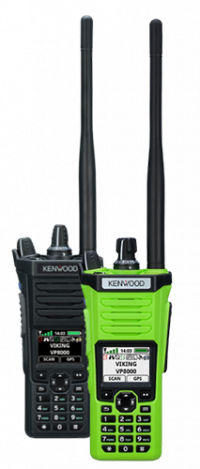 | |
| Market | Public Safety |
|---|---|
| Release Date | 2022 |
| Supported Features |
Conventional Analog Conventional P25 DMR T2/3 (TBD) Motorola Type II Trunking P25 Phase 1 Trunking |
The EF Johnson / Kenwood Viking VP8000 is an all-band public safety P25 radio, released in late 2022 as a competitor to the Motorola APX8000 and Harris XL-200p all-band radios.
Hardware
Keyloading Pinout
The VP8000, like the other radios using Kenwood's universal connector, can be keyloaded from a KFD keyloader using the KPG-93 cable, whose pinout is shown below.
Programming Cables
Officially, the radio can only be programmed with the KPG-236XU cable, which is expensive and hard to find.
Using the KPG-36X
The KPG-36X can be used with the VP8000, depending on the revision number. Units of revision 03550 or lower will function fine. Units of revision 03351 or newer will need to be modified to work with the VP8000 due to slight differences in the ciruitry.
The following information is from mpron on the Communications.Support forums. Two ferrite beads on the mainboard of the cable must be bypassed, and the pins connecting to the radio accessory connector must be rearranged.
Kenwood also released an official service bulletin advising of the same modifications to newer-revision KPG-36X cables:
File:FSB-1222-KPG36X-VP8000-Mod VP8000ProgrammingCableMod.pdf
The KPG-36z
The cable from BlueMax49ers has also been confirmed to work 100% with the VP8000.
Test Data
Some very basic test data from expirements with the radio.
| Power Consumption | |
|---|---|
| Power Off | 0.14 mA |
| On, Idle | 140 mA |
| Backlight | +77 mA |
| Bluetooth | +10 mA avg |
| WiFi | +30 mA avg |
| GPS | + 25 mA |
| TX, VHF, 5W | |
| TX, UHF, 5W | |
Bluetooth Compatability
Below is a curated list of bluetooth devices that have been confirmed either working or non-working. If you have bluetooth devices you've tested that aren't on this list, please email us!
| Manufacturer | Model | Compatible | Notes |
|---|---|---|---|
| Apple | AirPods 2 | ✅ Yes | Pairing is a little finnicky but RX audio does work fine |
| GoNovate | G10 | ✅ Yes | Works as an RX-only headset, no PTT |
| GoNovate | G8 | ❌ No | Pairs but presents Serial Port Profile (SPP) first, preventing audio from functioning |
| JLab | JBuds Mini | ❌ No | Pairs but audio does not work |
| NVAHVA | J18 | ❌ No | Does not pair properly |
| Sony | WF-C510 | ✅ Yes | |
| Sony | WF-XB700 | ✅ Yes | |
| Sony | WH-100XM4 | ✅ Yes | |
| SYSFUN | X7 | ❌ No | Does not pair properly |
Software
The VP8000 uses EFJ's Armada software suite, available from EF Johnson for a reasonable price. The radio can be programmed via USB, Bluetooth, or WiFi (using OTAP server).
No-Affiliate Scanning (NAS)
If you have valid system keys, you can passively scan a trunked system using a similar method to Motorola radios.
First, program up your trunk system like you normally would. Importantly, make sure you set up system preferred site lists if you're scanning a multi-site system! This is essential for proper scanning, otherwise the radio does weird things as it roams between sites.
Now, make sure all your talkgroups are set to TX disabled in your zone:
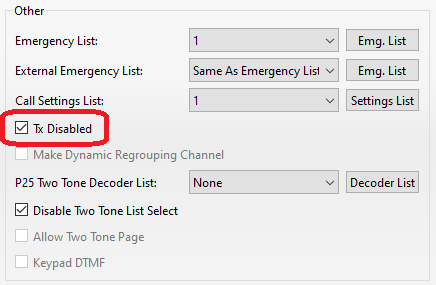
Make sure you never navigate to this zone while in-range of the system, or the radio will affiliate and you will have a bad day. I keep my NAS trunk zones at the top end of my zone list with empty "buffer" zones named "STOP" or a similar obvious title.
Next - create a radio-wide scanlist and add the trunk talkgroups you want to scan.
Make sure User Editable is disabled and the talkback type is "selected channel":

Finally, add a conventional channel and assign the radio-wide scanlist. I also usually enable auto-scan as well so I don't have to assign & press a RWS buton
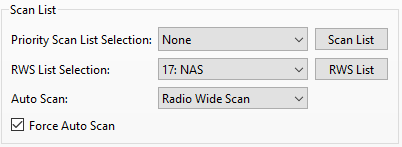
I am not responsible if you get your shiny new radio inhibited. Don't be stupid.
